Environmental Effective Assessment of Control Measures Implemented by Clean Air Action Plan (2013–2017) in Beijing, China
Abstract
:1. Introduction
2. Materials and Methods
2.1. Data Sources
2.2. Development of Economics and Society in Beijing
2.3. Assessment of Effects on the Environment
3. Results and Discussion
3.1. Emission Reductions of Control Measures
3.2. Emission Changes between 2012 and 2017
3.3. Impact of Changes in Pollutant Emissions on Air Quality Improvement
3.4. Assessment on the Improvement in Air Quality Attributed to the CAAP
3.5. Future Plans Regarding Air Pollution Control in Beijing
4. Conclusions
Author Contributions
Funding
Acknowledgments
Conflicts of Interest
References
- Jia, J.; Cheng, S.Y.; Lei, L.; Lang, J.L.; Gang, W.; Chen, G.L.; Liu, X.Y. An Integrated WRF-CAMx Modeling Approach for Impact Analysis of Implementing the Emergency PM2.5 Control Measures during Red Alerts in Beijing in December 2015. Aerosol Air Qual. Res. 2017, 17, 2491–2508. [Google Scholar] [CrossRef] [Green Version]
- Tian, J.Y.; Cai, T.Q.; Xu, G.; Shang, J.; Schauer, J.J.; Yang, S.J.; Zhang, L.J.; Zhang, Y.X. Effects of the emergency control measures in Beijing on air quality improvement. Atmos. Pollut. Res. 2019, 10, 580–586. [Google Scholar] [CrossRef]
- Wang, L.; Zhang, F.Y.; Pilot, E.; Yu, J.; Nie, C.J.; Holdaway, J.; Yang, L.S.; Li, Y.H.; Wang, W.; Vardoulakis, S. Taking Action on Air Pollution Control in the Beijing-Tianjin-Hebei (BTH) Region: Progress, Challenges and Opportunities. Int. J. Environ. Res. Public Health 2018, 15, 306. [Google Scholar] [CrossRef] [PubMed] [Green Version]
- Zhang, H.F.; Wang, S.X.; Hao, J.M.; Wang, X.M.; Wang, S.L.; Chai, F.H.; Mei, L. Air pollution and control action in Beijing. J. Clean. Prod. 2016, 112, 1519–1527. [Google Scholar] [CrossRef]
- Gao, J.M.; Xu, X.H.; Ying, Z.K.; Jiang, L.; Zhong, M.H.; Wang, A.X.; Chen, L.C.; Lu, B.; Sun, Q.H. Post-Effect of Air Quality Improvement on Biomarkers for Systemic Inflammation and Microparticles in Asthma Patients After the 2008 Beijing Olympic Games: A Pilot Study. Inflammation 2017, 40, 1214–1224. [Google Scholar] [CrossRef]
- Li, K.; Jacob, D.J.; Liao, H.; Zhu, J.; Shah, V.; Shen, L.; Bates, K.H.; Zhang, Q.; Zhai, S.X. A two-pollutant strategy for improving ozone and particulate air quality in China. Nat. Geosci. 2019, 12, 906–923. [Google Scholar] [CrossRef]
- Lin, H.L.; Liu, T.; Fang, F.; Xiao, J.P.; Zeng, W.L.; Li, X.; Guo, L.C.; Tian, L.W.; Schootman, M.; Stamatakis, K.A. Mortality benefits of vigorous air quality improvement interventions during the periods of APEC Blue and Parade Blue in Beijing, China. Environ. Pollut. 2017, 220, 222–227. [Google Scholar] [CrossRef] [Green Version]
- Wang, G.; Cheng, S.Y.; Wei, W.; Yang, X.W.; Wang, X.Q.; Jia, J.; Lang, J.L.; Lv, Z. Characteristics and emission-reduction measures evaluation of PM2.5 during the two major events: APEC and Parade. Sci. Total Environ. 2017, 595, 81–92. [Google Scholar] [CrossRef]
- Zeng, X.T.; Tong, Y.F.; Cui, L.; Kong, X.M.; Sheng, Y.N.; Chen, L.; Li, Y.P. Population-production-pollution nexus based air pollution management model for alleviating the atmospheric crisis in Beijing, China. J. Environ. Manag. 2017, 197, 507–521. [Google Scholar] [CrossRef]
- He, Q.Q.; Huang, B. Satellite-based high-resolution PM2.5 estimation over the Beijing-Tianjin-Hebei region of China using an improved geographically and temporally weighted regression model. Environ. Pollut. 2018, 236, 1027–1037. [Google Scholar] [CrossRef]
- Shen, Z.X.; Sun, J.; Cao, J.J.; Zhang, L.M.; Zhang, Q.; Lei, Y.L.; Gao, J.J.; Huang, R.J.; Liu, S.B.; Huang, Y. Chemical profiles of urban fugitive dust PM2.5 samples in Northern Chinese cities. Sci. Total Environ. 2016, 569–570, 619–626. [Google Scholar] [CrossRef] [PubMed]
- Song, L.; Song, H.; Lin, J.; Wang, C.; Yu, M.; Huang, X.; Guan, Y.; Wang, X.; Du, L. PM2.5 emissions from different types of heavy-duty truck: A case study and meta-analysis of the Beijing-Tianjin-Hebei region. Environ. Sci. Pollut. Res. 2017, 24, 11206–11214. [Google Scholar] [CrossRef] [PubMed]
- Yang, W.; Yu, C.Y.; Yuan, W.; Wu, X.Y.; Zhang, W.; Wang, X.J. High-resolution vehicle emission inventory and emission control policy scenario analysis, a case in the Beijing-Tianjin-Hebei (BTH) region, China. J. Clean. Prod. 2018, 203, 530–539. [Google Scholar] [CrossRef]
- Zhang, X.; Shi, M.; Li, Y.; Rui, P.; Nan, X. Correlating PM2.5 concentrations with air pollutant emissions: A longitudinal study of the Beijing-Tianjin-Hebei region. J. Clean. Prod. 2018, 179, 103–113. [Google Scholar] [CrossRef]
- Shao, P.Y.; Tian, H.Z.; Sun, Y.J.; Liu, H.J.; Wu, B.B.; Liu, S.H.; Liu, X.Y.; Wu, Y.; Liang, W.; Wang, Y.M.; et al. Characterizing remarkable changes of severe haze events and chemical compositions in multi-size airborne particles (PM1, PM2.5 and PM10) from January 2013 to 2016–2017 winter in Beijing, China. Atmos. Environ. 2018, 189, 133–144. [Google Scholar] [CrossRef]
- Vu, T.V.; Shi, Z.B.; Cheng, J.; Zhang, Q.; He, K.B.; Wang, S.X.; Harrison, R.M. Assessing the impact of clean air action on air quality trends in Beijing using a machine learning technique. Atmos. Chem. Phys. 2019, 19, 11303–11314. [Google Scholar] [CrossRef] [Green Version]
- Xue, Y.F.; Wang, Y.; Li, X.F.; Tian, H.Z.; Nie, L.; Wu, X.Q.; Zhou, J.R.; Zhou, Z. Multi-dimension apportionment of clean air “parade blue” phenomenon in Beijing. J. Environ. Sci. 2018, 65, 29–42. [Google Scholar] [CrossRef]
- Yang, J.; Song, D.; Fang, D.L.; Wu, F. Drivers of consumption-based PM2.5 emission of Beijing: A structural decomposition analysis. J. Clean. Prod. 2019, 219, 734–742. [Google Scholar] [CrossRef]
- Chen, Z.Y.; Chen, D.L.; Kwan, M.P.; Chen, B.; Gao, B.B.; Zhuang, Y.; Li, R.Y.; Xu, B. The control of anthropogenic emissions contributed to 80% of the decrease in PM2.5 concentrations in Beijing from 2013 to 2017. Atmos. Chem. Phys. 2019, 19, 13519–13533. [Google Scholar] [CrossRef] [Green Version]
- Xue, Y.F.; Zhang, S.H.; Zhou, Z.; Wang, K.; Liu, K.Y.; Wang, X.Y.; Shi, A.J.; Xu, K.L.; Tian, H.Z. Spatio-Temporal Variations of Multiple Primary Air Pollutants Emissions in Beijing of China, 2006–2015. Atmosphere 2019, 10, 494. [Google Scholar] [CrossRef] [Green Version]
- Cui, Z.K.; Li, Z.G.; Zhang, Y.Z.; Wang, X.F.; Li, Q.L.; Zhang, L.M.; Feng, X.B.; Li, X.Y.; Shang, L.H.; Yao, Z.X. Atmospheric Mercury Emissions from Residential Coal Combustion in Guizhou Province, Southwest China. Energy Fuels 2019, 33, 1937–1943. [Google Scholar] [CrossRef]
- Liu, S.J.; Ju, S.G.; Yang, S.; Du, W.G.; Yan, X.D.; Zhang, K.X. Producing Effective and Clean Coke for Household Combustion Activities to Reduce Gaseous Pollutant Emissions. J. Chem. 2019, 2019, 7142804. [Google Scholar] [CrossRef]
- Ouyang, J.; Song, L.J.; Ma, L.L.; Luo, M.; Dai, X.X.; Zhang, J.T.; Xu, D.D. Quantification of secondary particle loading during a heavy air pollution event in Beijing: A simplified method based on coal emission indicators. Atmos. Environ. 2019, 215, 116896. [Google Scholar] [CrossRef]
- Zhang, Z.Z.; Wang, W.X.; Cheng, M.M.; Liu, S.J.; Xu, J.; He, Y.J.; Meng, F. The contribution of residential coal combustion to PM2.5 pollution over China’s Beijing-Tianjin-Hebei region in winter. Atmos. Environ. 2017, 159, 147–161. [Google Scholar] [CrossRef]
- Nie, T.; Nie, L.; Zhou, Z.; Wang, Z.S.; Xue, Y.F.; Gao, J.J.; Wu, X.Q.; Fan, S.B.; Cheng, L.L. Exploring the heavy air pollution in Beijing in the fourth quarter of 2015: Assessment of environmental benefits for red alerts. Front. Earth Sci. 2018, 12, 361–372. [Google Scholar] [CrossRef]
- Dai, Q.L.; Bi, X.H.; Song, W.B.; Li, T.K.; Liu, B.S.; Ding, J.; Xu, J.; Song, C.B.; Yang, N.W.; Schulze, B.C.; et al. Residential coal combustion as a source of primary sulfate in Xi’an, China. Atmos. Environ. 2019, 196, 66–76. [Google Scholar] [CrossRef]
- Xu, W.; Song, W.; Zhang, Y.Y.; Liu, X.J.; Zhang, L.; Zhao, Y.H.; Liu, D.Y.; Tang, A.H.; Yang, D.W.; Wang, D.D. Air Quality Improvement in a Megacity: Implications from 2015 Beijing Parade Blue Pollution-Control Actions. Atmos. Chem. Phys. 2017, 17, 31–46. [Google Scholar] [CrossRef] [Green Version]
- Cheng, J.; Su, J.P.; Cui, T.; Li, X.; Dong, X.; Sun, F.; Yang, Y.Y.; Tong, D.; Zheng, Y.X.; Li, Y.S.; et al. Dominant role of emission reduction in PM2.5 air quality improvement in Beijing during 2013–2017: A model-based decomposition analysis. Atmos. Chem. Phys. 2019, 19, 6125–6146. [Google Scholar] [CrossRef] [Green Version]
- Zhang, Q.R.; Tong, P.F.; Liu, M.D.; Lin, H.M.; Yun, X.; Zhang, H.R.; Tao, W.; Liu, J.F.; Wang, S.X.; Tao, S.; et al. A WRF-Chem model-based future vehicle emission control policy simulation and assessment for the Beijing-Tianjin-Hebei region, China. J. Environ. Manag. 2020, 253, 109751. [Google Scholar] [CrossRef]
- Lang, J.L.; Tian, J.J.; Zhou, Y.; Li, K.H.; Chen, D.S.; Huang, Q.; Xing, X.F.; Zhang, Y.Y.; Cheng, S.Y. A high temporal-spatial resolution air pollutant emission inventory for agricultural machinery in China. J. Clean. Prod. 2018, 183, 1110–1121. [Google Scholar] [CrossRef]
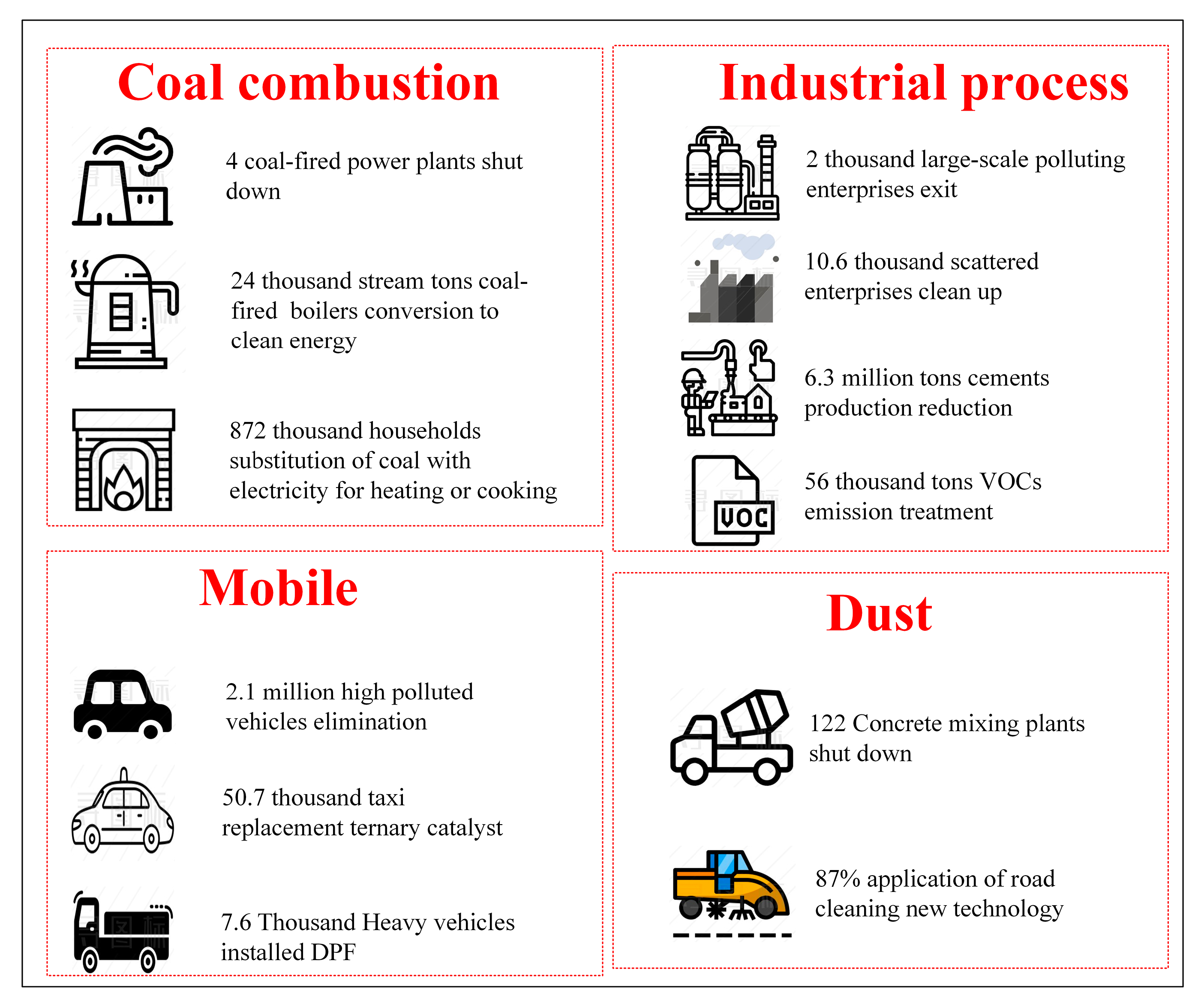
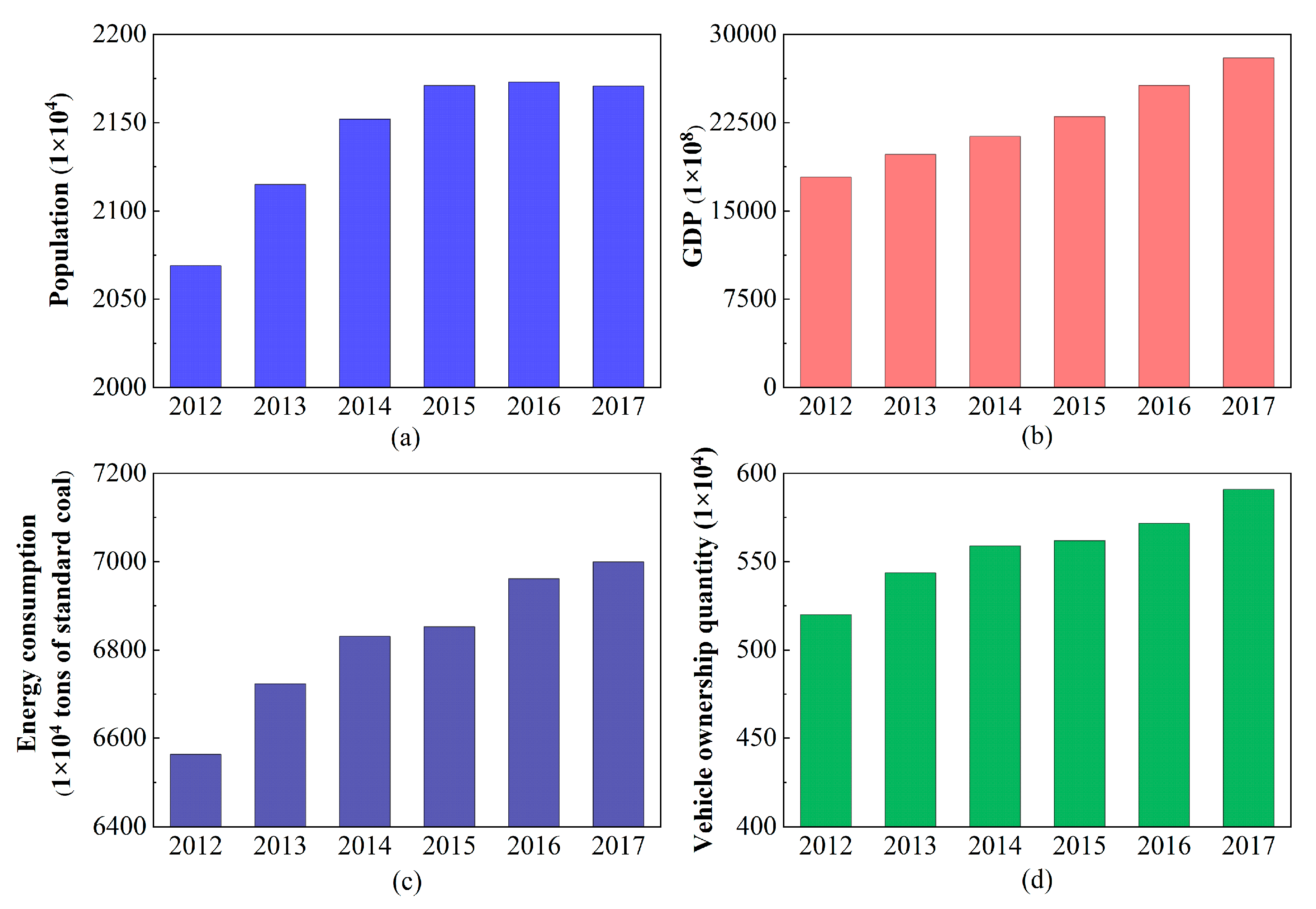
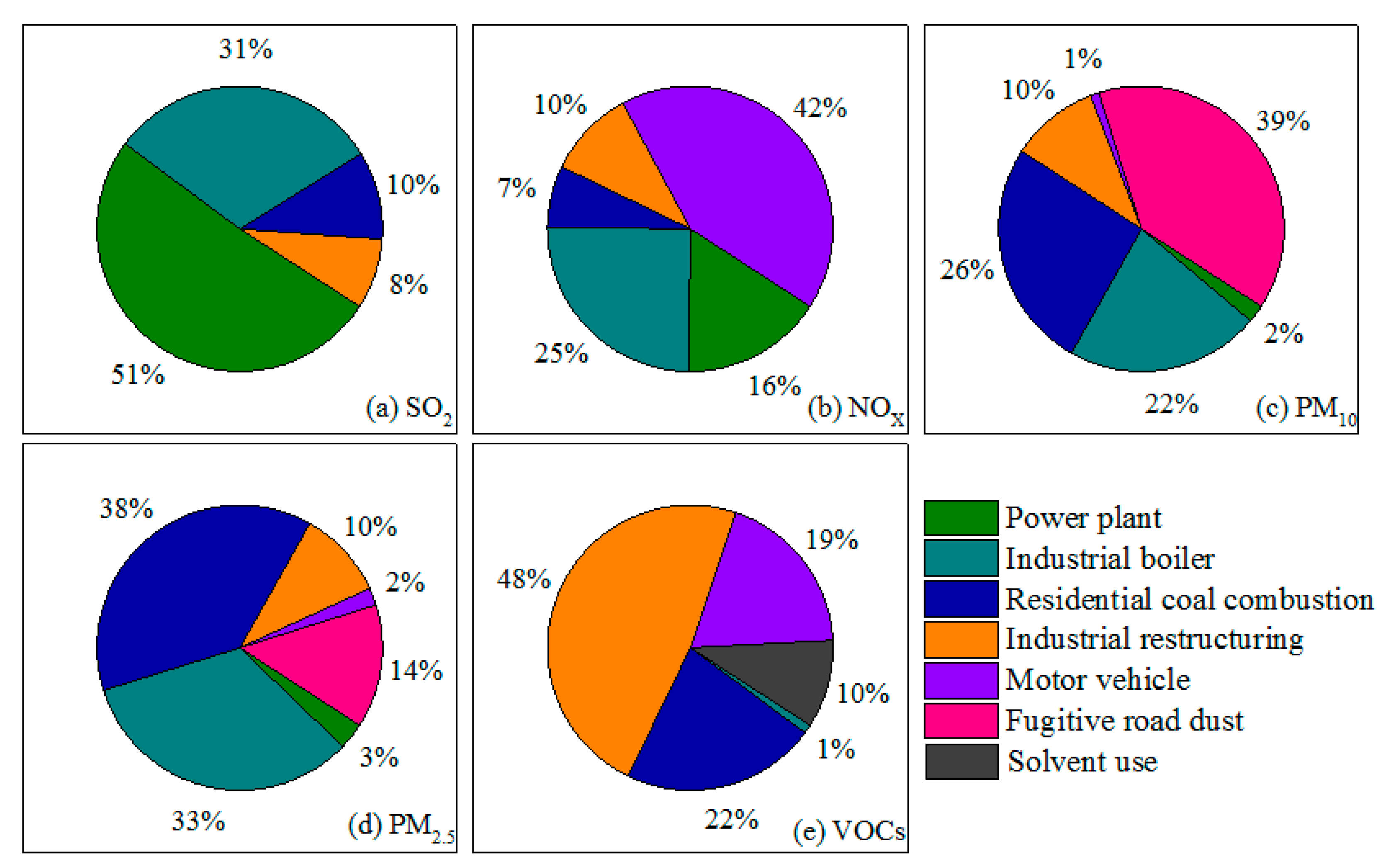
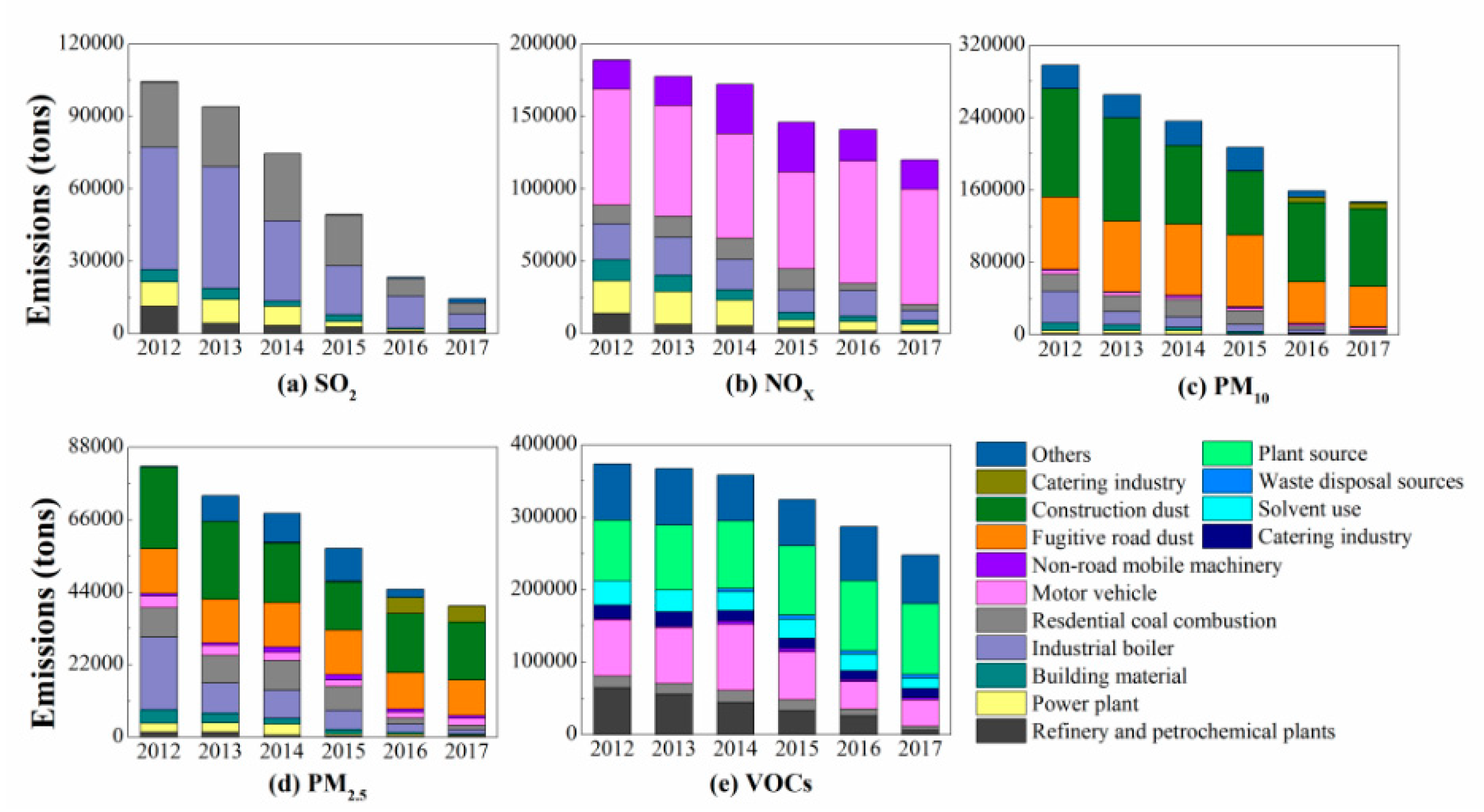
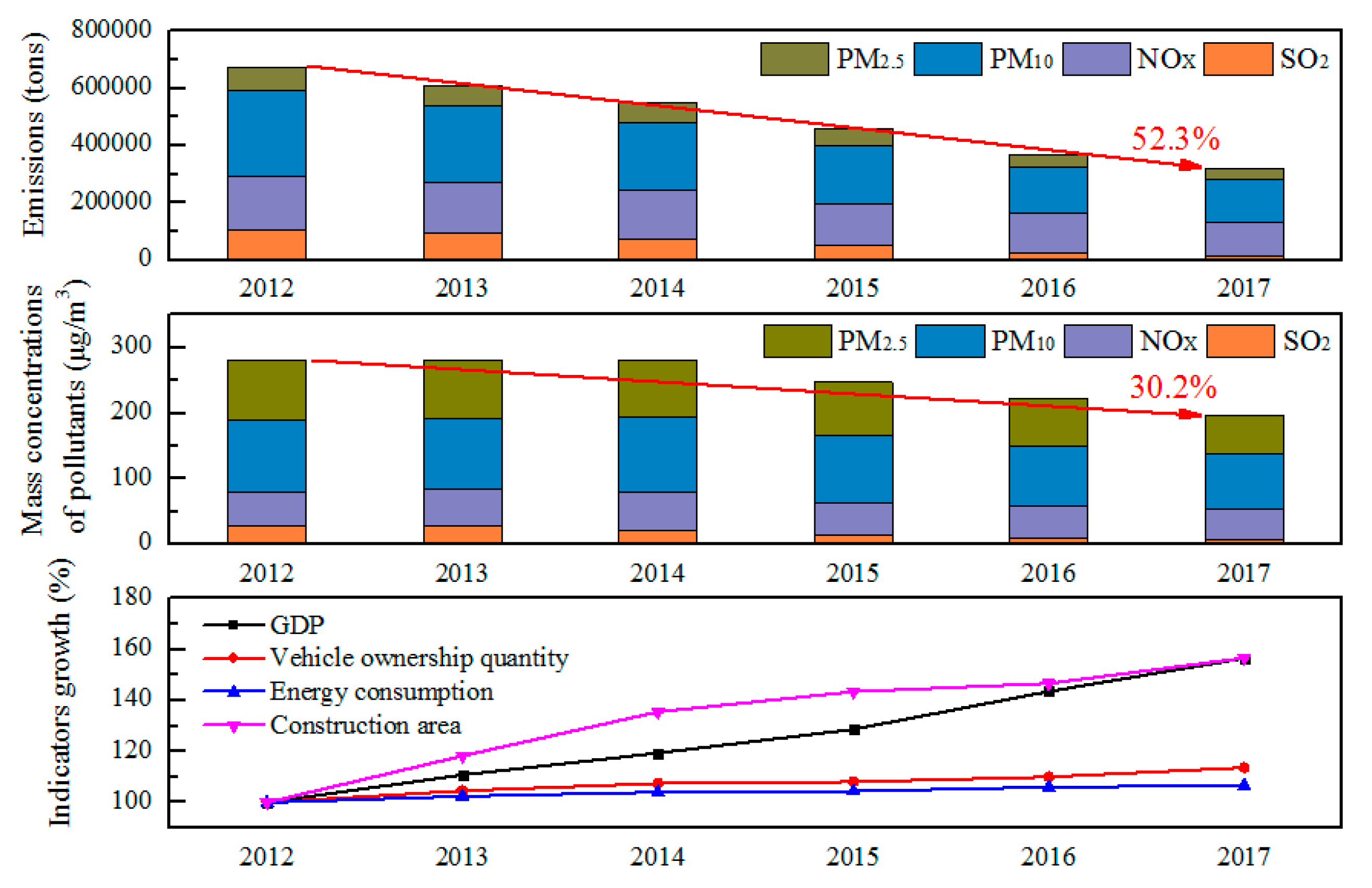

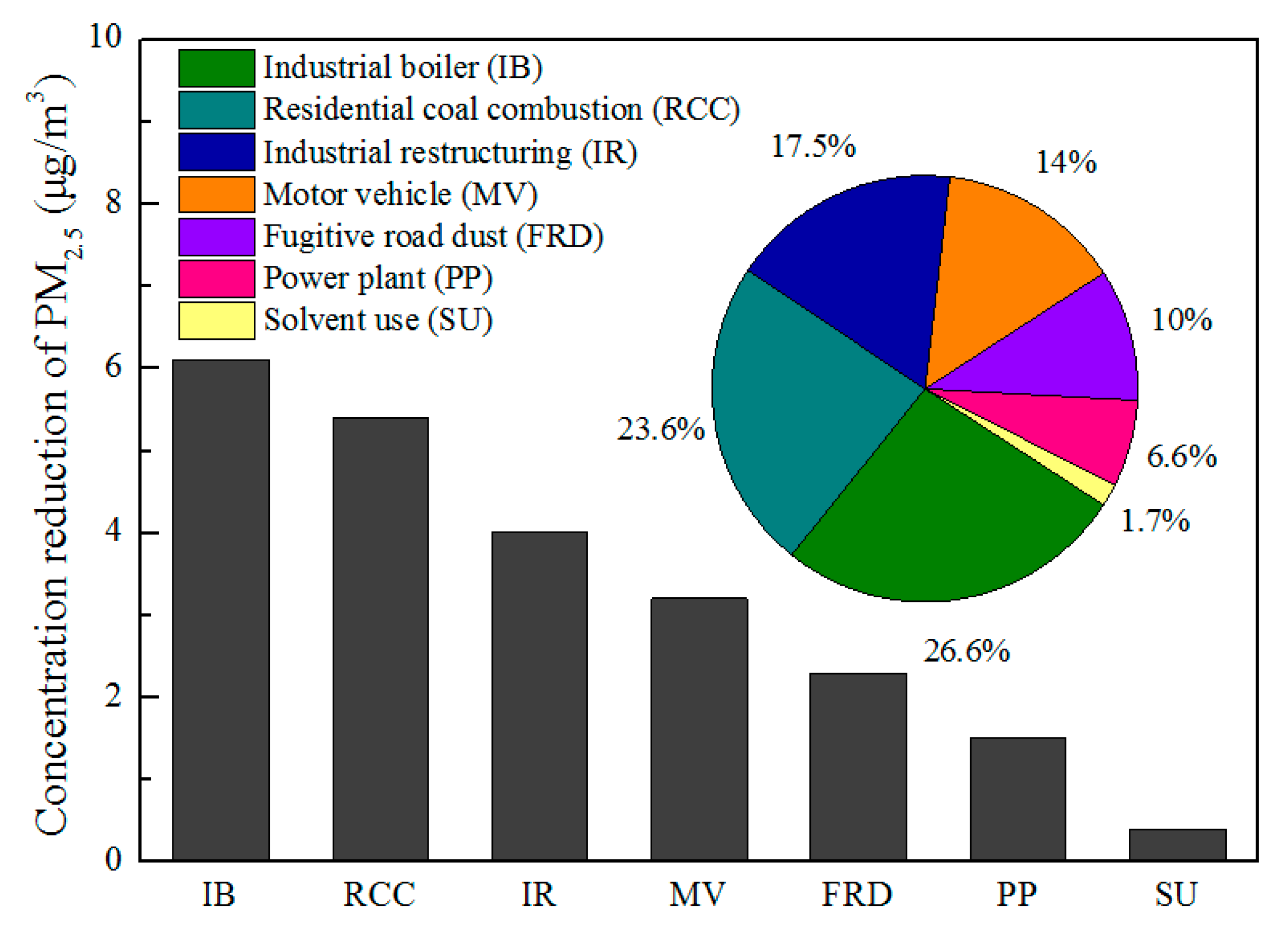
| Source Catalog | SO2 | NOX | PM10 | PM2.5 | VOCs | |
|---|---|---|---|---|---|---|
| Fossil fuel combustion | Power plant | 9993 | 19,054 | 2534 | 1495 | 356 |
| Industrial boiler | 61,221 | 28,812 | 25,909 | 15,286 | 539 | |
| Residential coal combustion | 36,550 | 8600 | 30,526 | 18,010 | 21,500 | |
| Industrial process | Industrial structure adjustment | 12,150 | 11,360 | 11,456 | 4530 | 46,847 |
| Solvent use | —— | 0 | 0 | 0 | 0 | 9385 |
| Mobile source | Vehicle | 10 | 48,265 | 1035 | 910 | 18,640 |
| Dust source | Road dust | 0 | 0 | 45,350 | 6420 | 0 |
| Total | 119,924 | 116,091 | 116,810 | 46,652 | 97,267 | |
© 2020 by the authors. Licensee MDPI, Basel, Switzerland. This article is an open access article distributed under the terms and conditions of the Creative Commons Attribution (CC BY) license (http://creativecommons.org/licenses/by/4.0/).
Share and Cite
Xue, Y.; Zhang, S.; Nie, T.; Cao, X.; Shi, A. Environmental Effective Assessment of Control Measures Implemented by Clean Air Action Plan (2013–2017) in Beijing, China. Atmosphere 2020, 11, 189. https://doi.org/10.3390/atmos11020189
Xue Y, Zhang S, Nie T, Cao X, Shi A. Environmental Effective Assessment of Control Measures Implemented by Clean Air Action Plan (2013–2017) in Beijing, China. Atmosphere. 2020; 11(2):189. https://doi.org/10.3390/atmos11020189
Chicago/Turabian StyleXue, Yifeng, Shihao Zhang, Teng Nie, Xizi Cao, and Aijun Shi. 2020. "Environmental Effective Assessment of Control Measures Implemented by Clean Air Action Plan (2013–2017) in Beijing, China" Atmosphere 11, no. 2: 189. https://doi.org/10.3390/atmos11020189





